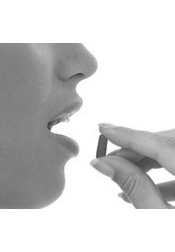Rofact® capsules
This product is manufactured by Bausch Health Canada using the ingredient rifampin.
This product is taken orally.

play
orally
Why is it prescribed?
Rifampin is used in combination with other antitubercular medications to treat tuberculosis in adults and children.
It is very important to take Rofact® exactly as directed by your doctor. Never stop taking the medication without permission.
Try not to miss any doses. If you do miss a dose of this medicine, take it as soon as possible. However, if it is almost time for your next dose, skip the missed dose and go back to your regular dosing schedule. Do not double dose(unless you have been instructed to do so); resume your normal dosing schedule.
Rofact® is absorbed best if taken 1 hour before a meal or 2 hours after a meal but may be taken with food if stomach upset occurs. Take with a full glass of water. If you take antacids, ensure to take the daily dose of Rofact® at least one hour before ingestion of an antacid. Alcohol consumption should be at a minimum to reduce the possibility of liver problems.
Notify your doctor if you experience any of the following: yellowing of the skin or eyes, excessive tiredness or weakness, appetite loss, nausea, vomiting, sore throat, unusual bleeding or bruising, eye irritation or itching.
Alternatives
See other products used in the treatment of •tuberculosis •
Treatment of tuberculosis (in combination with at least 1 other antitubercular agent):
Adult: 600 mg once a day for the entire treatment period; or 10 mg per kg of body weight, up to 600 mg, two or three times a week, depending on the treatment regimen.
Children: 10 to 20 mg per kg of body weight, up to 600 mg, once a day; or 10 to 20 mg per kg of body weight, up to 600 mg, two or three times a week, depending on the treatment regimen.
Rifampin is an antituberculosis drug that can be either bactericidal (kill bacteria) or bacteriostatic (inhibit bacterial growth), depending on the concentration of the drug in the body. It is thought to inhibit certain pathways that are needed for the bacteria to grow.
Along with its needed effects, rifampin may cause some unwanted or undesirable effects. Rifampin is generally well tolerated in most people. The frequency and severity of unwanted effects depend on many factors including dose, age of the person, existing health problems and individual response. Possible unwanted effects include:
- appetite loss
- nausea
- stomach ache
- dizziness
- drowsiness
- rash
- itching
- flushing
- headache
- gas
- tiredness
- reddish-orange discoloration of bodily fluids (e.g. sweat,tears, etc.)
Uncommon:
- vomiting
- diarrhea
- menstrual irregularities
- confusion
- jaundice (yellowing of skin and eyes)
Rare:
- muscle weakness
- shortness of breath, wheezing
- visual disturbances
If you are (or suspect you are) experiencing any unwanted effects, report them to your doctor or pharmacist.
Rifampin may turn sweat, tears, sputum, feces, urine and saliva a red-orange color but this is not harmful. Soft contact lenses should not be worn during rifampin therapy as they may become permanently stained.
The effectiveness of oral contraceptives cannot be relied upon while on rifampin therapy. It is recommended that alternative or additional methods of birth control be used.
Drug interactions: It is important to tell your doctor and pharmacist about any prescription or over-the-counter medications you are taking to help avoid any serious drug interactions. The dose of one or both medications may need to be altered or a new drug may be prescribed. In some cases, one of the drugs may have to be discontinued. The following drugs and drug classes have been known to interact with rifampin.
- blood thinners (e.g. warfarin)
- benzodiazepines (e.g. diazepam)
- barbiturates (e.g. phenobarbital)
- hydantoins (e.g. phenytoin)
- beta-blockers (e.g. propranolol)
- ketoconazole
- oral contreceptives (e.g. Triphasil®)
- corticosteroids (e.g. prednisone)
- cyclosporine (e.g. Neoral®)
- digoxin (e.g. Lanoxin®)
- disopyramide (e.g. Rythmodan®)
- enalapril (e.g. Vasotec®)
- estrogens (e.g. Premarin®)
- methadone
- quinidine
- sulfonylureas (e.g. tolbutamide)
- theophylline (e.g. Theo-Dur®)
- verapamil (e.g. Isoptin®)
- antacids
Use is not recommended in the following situations:
- jaundice (yellowing of the skin and eyes)
- allergy to rifampin or any other rifamycin
Caution is recommended in the following situations:
- liver disease
Use in pregnancy: Rifampin is the drug of choice in pregnancy. Contact your doctor if you suspect you may be pregnant.
Use while breastfeeding: Rifampin passes into breast-milk in small amounts. Contact your doctor or pharmacist before use.
